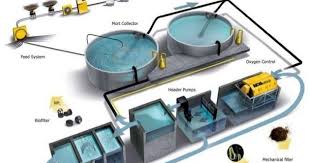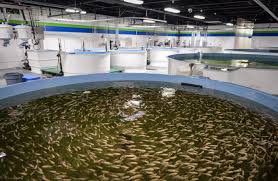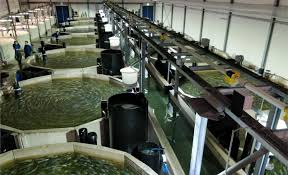Recirculating systems in fish farming are innovative aquaculture technologies that recycle water to create sustainable and efficient fish production environments. These systems are designed to minimize water usage, reduce environmental impacts, and improve overall fish health.
As global demand for seafood increases, recirculating aquaculture systems (RAS) offer a viable solution to meet this demand while addressing the challenges associated with traditional fish farming practices.
In traditional fish farming, also known as aquaculture, water is often sourced from natural bodies, such as rivers and lakes. This method can lead to overfishing, habitat destruction, and water pollution.
Moreover, open systems are vulnerable to diseases, parasites, and environmental fluctuations, which can adversely affect fish populations.
In contrast, recirculating systems in fish farming use advanced technology to filter and clean water, allowing it to be reused multiple times within the same facility. By maintaining optimal water quality, these systems can enhance fish growth and reduce mortality rates.
One of the key components of recirculating aquaculture systems is the biofilter, which uses beneficial bacteria to convert harmful ammonia and nitrites byproducts of fish waste into less harmful nitrates. This process, known as nitrification, is crucial for maintaining a healthy aquatic environment.
In addition to biofiltration, recirculating systems often incorporate mechanical filtration, UV sterilization, and oxygenation systems to ensure high water quality and optimal living conditions for the fish.
The benefits of recirculating systems in fish farming extend beyond water conservation and environmental protection. These systems can be implemented in various locations, including urban areas, where traditional fish farming may not be feasible.
This versatility allows for localized production, reducing the carbon footprint associated with transporting seafood from remote locations. Furthermore, RAS can produce fish year-round, independent of seasonal changes, leading to a more stable supply of fresh seafood.
Another advantage of recirculating systems is their potential for enhanced biosecurity. Since water is reused and contained within the system, the risk of disease outbreaks from external sources is significantly reduced.
This feature is particularly important as fish farming operations increasingly face challenges from pathogens and parasites. RAS allows for better control over fish health and welfare, ultimately leading to higher-quality products.
Despite these advantages, recirculating systems in fish farming also present some challenges. The initial capital investment for setting up RAS can be substantial, as the technology and infrastructure required can be costly.
Additionally, managing a recirculating system requires a certain level of technical expertise, which may not be readily available to all fish farmers. However, as technology advances and becomes more affordable, the adoption of recirculating aquaculture systems is expected to grow.
Components of Recirculating Systems in Fish Farming

1. Fish Tanks: The primary component of RAS, fish tanks are where the fish are reared. These tanks can vary in size and shape, depending on the species being farmed and the scale of the operation. They are typically designed to facilitate optimal water circulation and fish growth.
2. Water Treatment Units: These units are crucial for maintaining water quality. They include mechanical filters to remove solids, biological filters for ammonia conversion into less harmful compounds, and UV sterilizers to eliminate pathogens and parasites.
3. Pumps and Aeration Systems: Pumps circulate water throughout the system, ensuring that it moves efficiently between the fish tanks and treatment units. Aeration systems add oxygen to the water, which is essential for fish respiration and overall health.
4. Heat Exchangers: In many RAS setups, heat exchangers are used to maintain optimal water temperatures for the fish species being cultured. They can be essential for temperature-sensitive species and contribute to improved growth rates and feed conversion.
5. Monitoring and Control Systems: These systems continuously monitor water quality parameters such as temperature, pH, dissolved oxygen, and ammonia levels. Automated control systems can adjust these parameters to maintain ideal conditions for fish growth.
6. Backup Systems: These are critical for ensuring the resilience of RAS. Backup systems may include generators to maintain power supply, additional pumps, and emergency water sources to prevent fish mortality during system failures.
How Recirculating Systems Work
Recirculating aquaculture systems operate on a closed-loop principle, where water is continuously reused. Here’s how they function:
1. Water Collection: Water is drawn from the fish tanks, where fish waste and uneaten feed accumulate, creating a need for treatment.
2. Mechanical Filtration: The first step in water treatment involves mechanical filtration to remove large particles and solids. This process helps reduce the organic load in the system.
3. Biological Filtration: After mechanical filtration, the water is treated biologically. Beneficial bacteria convert harmful ammonia, produced from fish waste, into nitrites and then into nitrates. This biological process is essential for maintaining water quality.
4. Aeration: Oxygen is added to the water through aeration, ensuring that fish have sufficient dissolved oxygen for respiration. This step is crucial for maintaining fish health and growth.
5. UV Sterilization: In some systems, UV sterilization is employed to eliminate pathogens and improve water quality. This step is important for disease prevention and maintaining a healthy fish population.
6. Return to Tanks: The treated water is then recirculated back into the fish tanks, completing the cycle. This closed-loop system allows for efficient water use and minimizes the need for additional water inputs.
Benefits of Using Recirculating Systems in Aquaculture
1. Water Conservation: RAS significantly reduces water usage compared to traditional aquaculture methods. By recycling water, farmers can decrease their reliance on freshwater resources, which is especially important in areas with limited water supply.
2. Improved Water Quality: Continuous filtration and treatment processes ensure high water quality, which is critical for fish health and growth. Good water quality can lead to better feed conversion rates and overall production efficiency.
3. Disease Management: The controlled environment of RAS reduces the risk of disease outbreaks. With fewer interactions with wild fish populations and improved biosecurity measures, farmers can achieve healthier fish stocks.
4. Space Efficiency: RAS can be installed in various locations, including urban settings. These systems can maximize space use, allowing for high-density fish farming in smaller areas.
5. Sustainable Practices: By minimizing waste production and energy consumption, RAS promotes sustainable aquaculture practices. Farmers can produce fish with lower environmental impact while meeting the growing global demand for seafood.
6. Flexibility and Control: RAS allows farmers to have greater control over the farming environment. They can adjust water parameters, temperature, and feeding schedules to optimize fish growth and health.
Read Also: 5 Medicinal Health Benefits of Scutellaria nana (Dwarf Skullcap)
Types of Fish Suitable for Recirculating Systems

Selecting the right fish species is crucial for the success of RAS. Here are some fish that thrive in recirculating systems:
1. Tilapia: Known for their resilience and fast growth rates, tilapia are one of the most commonly farmed species in RAS. They adapt well to varying water quality conditions and have a high tolerance for crowding.
2. Salmon: Salmon are ideal for RAS due to their high market demand and ability to thrive in controlled environments. They require specific temperature and oxygen levels, making them suitable for systems designed to meet these needs.
3. Catfish: Catfish are hardy fish that grow quickly in RAS. They have a high tolerance for low oxygen levels, making them a good choice for recirculating systems where oxygen management can be a challenge.
4. Trout: Trout species, particularly rainbow trout, are commonly raised in RAS. They require cooler water temperatures and high oxygen levels, making them well-suited for systems designed to provide optimal conditions.
5. Barramundi: This fish is gaining popularity in RAS due to its rapid growth and adaptability. Barramundi can thrive in various salinities, making them a versatile choice for aquaculture.
Water Quality Management in Recirculating Systems
Maintaining high water quality is essential for the health and growth of fish in RAS. Key parameters to monitor include:
1. Temperature: Optimal temperature ranges vary by species. Regular monitoring and adjustments help maintain suitable conditions for fish growth.
2. pH Levels: pH influences fish health and nutrient availability. Most fish thrive in a pH range of 6.5 to 8.5. Regular testing ensures that levels remain within the desired range.
3. Ammonia and Nitrite Levels: Ammonia is toxic to fish, so monitoring its levels is critical. Biological filtration helps convert ammonia into less harmful nitrites and nitrates. Regular testing ensures these levels remain low.
4. Dissolved Oxygen (DO): Fish require adequate dissolved oxygen for respiration. Monitoring and maintaining DO levels above 5 mg/L is essential for fish health.
5. Nutrient Levels: Monitoring nutrient levels is important for maintaining water quality. High nutrient concentrations can lead to algae blooms, negatively impacting fish health.
Filtration Systems in Recirculating Aquaculture
Effective filtration is a cornerstone of RAS, helping to maintain water quality and reduce waste. Key types of filtration systems include:
1. Mechanical Filters: These filters remove solid waste and debris from the water. Common types include drum filters, screen filters, and bead filters, which physically strain particles from the water.
2. Biological Filters: Biological filters support beneficial bacteria that convert harmful ammonia into less toxic compounds. Trickling filters, fluidized bed filters, and moving bed biofilm reactors are popular biological filtration methods.
3. UV Filters: Ultraviolet (UV) filters are used to sterilize water by killing pathogens and parasites. UV filtration improves water quality and helps prevent disease outbreaks.
4. Chemical Filters: These filters use activated carbon or other media to remove dissolved organic compounds and toxins from the water, further improving water quality.
Oxygen Supply and Aeration Techniques
Adequate oxygen supply is crucial for fish health in RAS. Here are some aeration techniques used to ensure optimal oxygen levels:
1. Surface Aeration: This technique increases oxygen transfer by agitating the water surface. Paddlewheel aerators and surface aerators are commonly used in fish farming.
2. Diffused Aeration: Air is introduced into the water through fine bubbles using diffusers. This method increases the contact surface area for oxygen absorption, making it an efficient way to aerate water.
3. Oxygen Injection: In some systems, pure oxygen is injected directly into the water. This method ensures high dissolved oxygen levels, particularly in high-density fish farming.
4. Water Movement: Water circulation created by pumps can also help with oxygen distribution. Ensuring adequate water flow throughout the system aids in maintaining consistent oxygen levels.
Read Also: Tangerine and Mandarin Segments: Economic Importance, Uses and By-Products
Temperature Control in Recirculating Systems

Maintaining optimal water temperature is crucial for the health and growth of fish in RAS. Here are some key considerations:
1. Importance of Temperature Control: Fish are ectothermic animals, meaning their body temperature is influenced by their environment. Optimal temperature ranges vary by species and directly affect metabolic rates, growth, reproduction, and overall health.
2. Heating and Cooling Systems: Proper heating and cooling systems are vital for maintaining consistent temperatures. Common methods include:
i. Heaters: Electric or gas heaters can raise water temperatures as needed.
ii. Chillers: Refrigeration units help lower water temperatures, especially in warm climates or during summer months.
iii. Heat Exchangers: These systems utilize ambient air or water to regulate temperature without adding additional heat or cooling energy.
3. Monitoring Temperature: Regular monitoring of water temperature is essential. Digital thermometers and automated monitoring systems can provide real-time data, allowing for quick adjustments as necessary.
4. Temperature Fluctuations: Sudden temperature changes can stress fish and impact growth rates. Gradual adjustments are recommended to avoid thermal shock.
Common Challenges in Recirculating Aquaculture Systems
While RAS has many benefits, several challenges can impact its effectiveness:
1. Water Quality Management: Maintaining optimal water quality is critical. High ammonia levels, low dissolved oxygen, and poor pH balance can adversely affect fish health. Regular testing and efficient filtration systems are necessary to manage these parameters.
2. Disease Management: The close quarters in RAS can facilitate the spread of diseases. Regular health monitoring, vaccination, and biosecurity measures are crucial for preventing outbreaks.
3. Technical Issues: Mechanical failures in filtration, heating, or aeration systems can disrupt operations. Regular maintenance and backup systems can help mitigate risks associated with equipment failure.
4. Economic Viability: Initial investment costs can be high, and ensuring profitability can be challenging. Careful planning and market research are essential for a successful venture.
5. Knowledge and Expertise: Operating a RAS requires specialized knowledge in aquaculture practices, water quality management, and fish health. Continuous education and training are necessary for successful management.
Cost Considerations for Setting Up Recirculating Systems
Understanding the costs associated with setting up a recirculating aquaculture system is vital for long-term success:
1. Initial Investment: The setup costs for RAS can be significant. Key expenses include:
i. Construction Costs: Building the infrastructure for tanks, filtration systems, and supporting equipment.
ii. Equipment Costs: Purchasing heating, cooling, filtration, and aeration systems.
2. Operational Costs: Ongoing costs can include:
i. Energy Costs: Electricity for heating, cooling, and pumps can be a major expense.
ii. Water Treatment Costs: Regular testing and treatment of water quality parameters can add to operational expenses.
iii. Feed Costs: Quality feed is essential for fish growth and health.
3. Economic Viability: Analyzing potential revenue from fish sales against operational costs is crucial for determining profitability. Factors to consider include market demand, pricing, and production efficiency.
4. Funding and Grants: Exploring grants, loans, and financial assistance programs can help offset initial and operational costs. Many governments and organizations support sustainable aquaculture practices.
Do you have any questions, suggestions, or contributions? If so, please feel free to use the comment box below to share your thoughts. We also encourage you to kindly share this information with others who might benefit from it. Since we can’t reach everyone at once, we truly appreciate your help in spreading the word. Thank you so much for your support and for sharing!
Read Also: The Power of Free Education: How It Can Transform Lives

